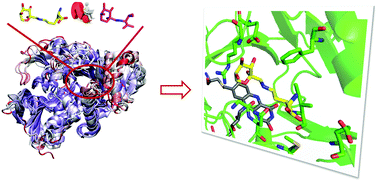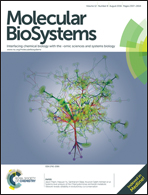Molecular dynamics simulations provide insights into the substrate specificity of FAOX family members†
Abstract
Enzymatic assays based on Fructosyl Amino Acid Oxidases (FAOX) represent a potential, rapid and economical strategy to measure glycated hemoglobin (HbA1c), which is in turn a reliable method to monitor the insurgence and the development of diabetes mellitus. However, the engineering of naturally occurring FAOX to specifically recognize fructosyl-valine (the glycated N-terminal residue of HbA1c) has been hindered by the paucity of information on the tridimensional structures and catalytic residues of the different FAOX that exist in nature, and in general on the molecular mechanisms that regulate specificity in this class of enzymes. In this study, we use molecular dynamics simulations and advanced modeling techniques to investigate five different relevant wild-type FAOX (Amadoriase I, Amadoriase II, PnFPOX, FPOX-E and N1-1-FAOD) in order to elucidate the molecular mechanisms that drive their specificity towards polar and nonpolar substrates. Specifically, we compare these five different FAOX in terms of overall folding, ligand entry tunnels, ligand binding residues and ligand binding energies. Our work will contribute to future enzyme structure modifications aimed at the rational design of novel biosensors for the monitoring of blood glucose levels.

- This article is part of the themed collection: Chemical Biology in Molecular BioSystems

 Please wait while we load your content...
Please wait while we load your content...